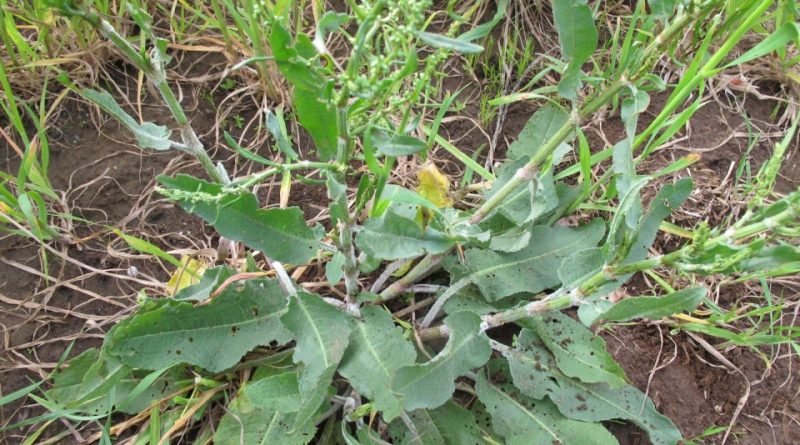Rumex conglomeratus
Rumex conglomeratus
The Sharp dock or Clustered dock (Rumex conglomeratus Murray) is a herbaceous species belonging to the Polygonaceae family.
Systematics –
From a systematic point of view it belongs to:
Eukaryota Domain,
Kingdom Plantae,
Subarign Tracheobionta,
Magnoliophyta Division,
Magnoliopsida class,
Subclass Caryophyllidae,
Polygonales Order,
Polygonaceae family,
Genus Rumex,
R. conglomeratus species.
The terms are synonymous:
– Acetosa conglomerata (Murray) M.Gómez;
– Lapathum conglomeratum (Murray) Gray;
– Rumex acutus Sm.;
– Rumex campestris Savi;
– Rumex exsanguis Kit. ex Schult.;
– Rumex ferrugineus Willd. ex Spreng.;
– Rumex foliosus Rech.f.;
– Rumex glomeratus Schreb.;
– Rumex lachanus Forssk.;
– Rumex litoralis Kunth;
– Rumex nemolapathum Ehrh.;
– Rumex nemorosus Schrad. ex Willd.;
– Rumex nevadensis H.Lindb.;
– Rumex parvifolius Willd. ex Schult. & Schult.f.;
– Rumex pusillus Delarbre;
– Rumex tauricus Schult. & Schult.f.;
– Rumex undulatus Schrank;
– Rumex virgatus Haenke;
– Rumex winterlii Zuccagni;
Etymology –
The term Rumex comes from rumex javelin, spear: due to the pointed shape of the leaves of many species of this genus. Already in Plautus and others with the meaning of romice.
The specific epithet conglomeratus comes from conglomer I wrap, aggomitolo, I collect together: collected in a complex of more or less spherical shape.
Geographic Distribution and Habitat –
Rumex conglomeratus is a plant native to Europe, Asia and North Africa; it was also introduced in North America.
In Europe it is present in the southern areas and in Italy it is present in all regions except in Val d’Aosta.
Its habitat is that of rather humid ruderal pioneer areas, in semi-shaded areas, along ditches, streams and ponds, on sandy to muddy soils rich in nitrogen compounds, from sea level to the lower mountain belt.
Description –
The Sharp dock is an annual or biennial plant, scapose hemicryptophyte, which normally grows between 30 and 90 cm in height.
It has a stem with upright-patent branches.
The leaves are alternate, simple, with stipules welded to form a short membranous sheath that embraces the stem, of a lanceolate-astate shape and eroded on the margin.
The flowers are hermaphroditic, regular, persistent, gathered in inflorescence which is interrupted at the base of the glomeruli.
The antesis is between June and August.
The fruit is a diclesium on pedicels longer than the oblong or linguiform ovate valves of 2.5-3 mm, achene of 1.5-1.9 mm, dark reddish-brown, visible on the side.
Cultivation –
Rumex conglomeratus is a herbaceous plant that is harvested in nature for local use as a food, medicine and source of materials.
It is a plant that grows in many types of soil but prefers deep, fertile, moderately heavy, humus-rich, moisture-retaining and also well-drained soils, with a position in full sun or partial shade.
Being pollinated by the wind, it usually easily hybridizes, especially with other plants of the same genus and, above all, with Rumex hydrolapathum, Rumex aquaticus, Rumex crispus, Rumex obtusifolius, Rumex maritimus and Rumex pulcher.
Propagation occurs by seed, with sowing directly in the open field or by division in spring.
Customs and Traditions –
The Sharp dock is a plant that has medicinal properties and can be used as an antiscorbutic, astringent.
This plant contains high oxalic acid, which is what gives the leaves a tangy lemon flavor.
The leaves should not be eaten in large quantities as oxalic acid can block other nutrients in foods, especially calcium, thus causing mineral deficiencies. The oxalic acid content is reduced if the plant is cooked.
For edible use, the cooked leaves can be consumed and eaten as a vegetable. They taste very bitter, especially as the leaves age.
The seeds can be eaten both raw and cooked and can be ground into powder and added to flours for the production of bread, biscuits, etc.
However the seeds are small and difficult to collect.
For medicinal use, the root is used which is antiscorbutic and astringent.
An infusion can be prepared which is taken internally in the treatment of scurvy and as a general cleanser of the blood. This infusion is also useful in the treatment of bleeding.
Externally it is used as an ointment and applied to skin rashes.
A decoction of the leaves is used in the treatment of various skin diseases.
Among other uses, it should be remembered that from the roots it is possible to obtain dyes from dark green to brown and dark gray that do not require a mordant.
Among the warnings it is emphasized that people with a tendency to rheumatism, arthritis, gout, kidney stones or hyperacidity should be especially careful if they include this plant in their diet as it can aggravate their condition.
Preparation Method –
Rumex conglomeratus is a plant that finds various uses both in the food, medicinal and in the field of dyes.
Both seeds, leaves and roots are used.
The roots are harvested in early spring and dried for later use.
The leaves are eaten cooked while the seeds can be eaten both cooked and raw; they can be ground to make flours to add to other preparations.
The root is used only in the medicinal field and from this infusions are prepared used both externally and internally.
From the leaves, decoctions are prepared for the treatment of various skin diseases.
Guido Bissanti
Sources
– Acta Plantarum – Flora of the Italian Regions.
– Wikipedia, the free encyclopedia.
– Useful Tropical Plants Database.
– Conti F., Abbate G., Alessandrini A., Blasi C. (ed.), 2005. An annotated checklist of the Italian vascular flora, Palombi Editore.
– Pignatti S., 1982. Flora of Italy, Edagricole, Bologna.
– Treben M., 2000. Health from the Lord’s Pharmacy, Advice and experiences with medicinal herbs, Ennsthaler Editore.
Warning: Pharmaceutical applications and alimurgical uses are indicated for informational purposes only, they do not represent in any way a medical prescription; therefore no responsibility is taken for their use for curative, aesthetic or food purposes.


